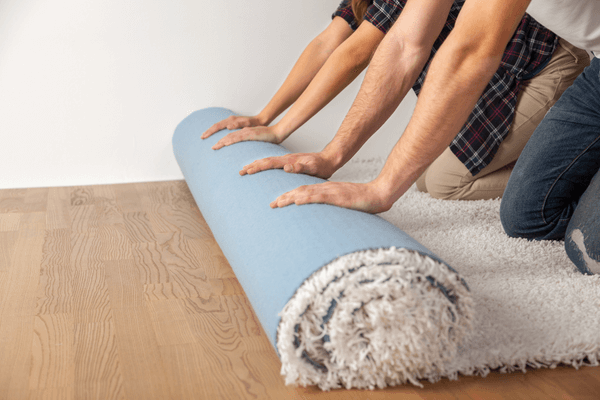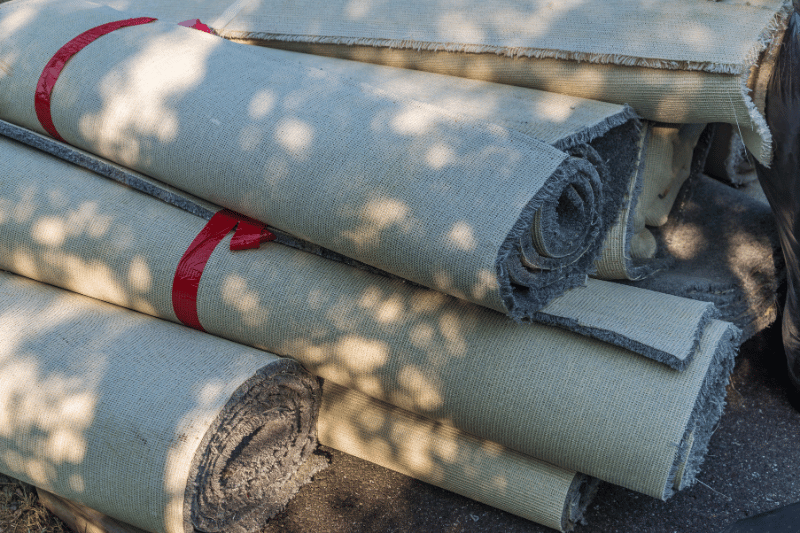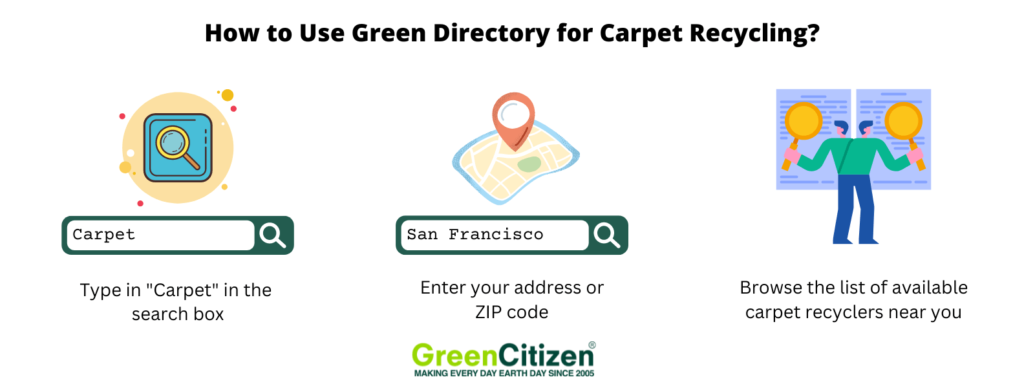Are you sick of your old carpets? Do you want to redecorate your floors and go for wood or stained concrete? It’s time to get rid of your old carpets. But how to dispose of carpets responsibly?
According to the EPA, over four billion pounds of carpets are sent to the waste stream in the US every year. Did you know that carpets take decades to decompose? The answer to the waste problem is carpet recycling. But it’s not as simple as it may seem. A carpet has to be completely free of any decontamination to be properly recycled.
Today, I’ll walk you through the entire process of carpet recycling and explain why you shouldn’t toss your old carpets into the trash.
Is Carpet Recyclable?
Yes, carpet is recyclable. Almost all kinds of carpets can be recycled. Depending on the fiber, the carpet can be broken down into raw materials and made into a new product. Used carpets can be turned into materials for products such as auto parts, plastic lumber, carpet pad, and more.

Although almost all kinds of carpets are recyclable, the recycling carpet process isn’t as simple as putting the carpet with other curbside recycling. Carpets are made from many layers of different materials, including fibers and plastic. These don’t degrade easily in landfill, which is why many municipalities don’t accept carpets with other household trash.
The best way to recycle a carpet is to drop it off at a designated waste disposal site.
Is Carpet Padding Recyclable?
Yes, carpet padding is recyclable. Carpet padding is the material underneath a carpet. The padding is easier to recycle than a carpet because it’s made of a single material, while the carpet consists of several materials. Most companies that accept carpets for recycling also accept carpet padding. However, carpet and carpet padding can’t be recycled together.

To recycle padding, it needs to be dry. You can roll it and take it to the carpet disposal place near you. Make sure there isn’t any waste in the carpet padding.
Pro Tip: Always ask the recycler if they accept both carpet and carpet padding for recycling.
Why Shouldn’t You Throw Your Carpets To The Trash?
Sending a carpet to the landfill is the same as sending plastics — it’s extremely difficult to break down, so it’ll stay in the landfill and pollute the environment forever.

There are several reasons why you shouldn’t throw carpets into the trash:
- It’s difficult to decompose because of complex and rigid fibers. Moreover, carpets release toxins into the air as they are burned in landfills.
- Decomposing and burning carpets can contaminate air and water, which can negatively affect animals and people.
- Throwing carpets into the trash leads to a waste of fossil fuels used to incinerate the carpets.
- The fibers can be repurposed for other products, especially carpeting and insulation. Used textiles in good condition can be turned into rags, which can be recycled into paper.
- Reusing materials from carpets to produce new materials lowers the use of fossil fuels. Plus, recycling your carpet and not sending it to the trash means lowering carbon emissions.
- Carpets sent to trash account for 2% of all municipal solid waste by volume and 1% by waste.
- If you recycle carpets, you’re freeing up space in landfills and creating valuable material in the production stream.
What Are Carpets Made of?
Most carpets are made of two elements: the outer fibers and the backing. These two parts are a mix of materials, including adhesives, dyes, and textiles.
The backing is usually made of latex or PVC. Latex is used mostly in residential places. PVC is usually found in commercial places, and it’s easier to recycle compared to latex.
The fibers are the part you see and walk on. Synthetic fibers make up over 99% of the fibers used to make carpets in the US. Synthetic fibers are made through chemical processes. Each of these fibers has its pros and cons.
These are the most common fibers used to make carpets.
Nylon
Nylon is used in about 50% of all carpets sold in the US. Nylon is extremely durable and has good performance, which is why it’s so popular. It’s resilient, has good yarn memory to hold twist, and reacts well to stain treatment. It also has good abrasion and is resistant to mildew.
If you have a lot of heavy traffic, a carpet made of nylon is a good choice.
There are two kinds of nylon fibers: 6 and 6.6. In all honesty, there’s not much difference between them. Both are easy to dye and wash. The main difference is that nylon 6 has a melting point of 216 degrees, while nylon 6.6 has a melting point of 263 degrees. This is why nylon 6.6 is the better option for temperature-performance products.
Overall, nylon is a highly sought material in the recycling process and has good economic value.
Polypropylene
Polypropylene is also called olefin. This is the fastest-growing fiber being used nowadays. It’s inexpensive and makes up 30% of the fiber used in the US.
Polypropylene has excellent stain resistance and is a great fiber for indoor-outdoor carpets.
PET (Polyethylene Terephthalate)
PET is very fade resistant and gives beautiful colors. Its main con is that it’s not as durable as nylon.
PET fiber carpets are available in a wide selection of textures and colors but aren’t as available as nylon carpets.

Wool
Wool is naturally resistant to crushing, soiling, stains, and fire. Most wood carpets are made with jute backing because it has excellent tuft bind.
Wool carpets look rich and feel soft to the touch. If you want a long-lasting carpet, wool is the best choice.
Acrylics
Acrylics look and feel like wool. However, they are of lower quality and tend to fuzz.
PTT (Polyethylene Trimethylene Terephthalate)
PTT is stronger than PET and is more easily cleaned. However, it’s also more expensive to produce, which is why carpets with PTT fibers are more expensive than PET ones.
How to Prepare Carpets for Recycling?
- You have to make sure to properly prepare the carpet for recycling, or carpet recyclers won’t accept it.
Contamination is the main reason why rug recycling businesses won’t accept a carpet. Contamination can come from bad carpet handling during the removal. For example, if demolition debris ends up with the carpet load. Carpet can also be contaminated by tack strips and nails. These are very serious because a small piece of metal can break the recycling equipment.
Other common contaminants are paint and drywall mud. Also, your carpet has to be clean of any body fluids, asbestos, and chemical contaminants.
Finally, too much moisture also prevents carpet recycling. Moisture makes the carpet heavy, and the recycling devices can’t test the fibers. Moreover, a moist carpet can be moldy or have mildew. You should protect the carpet from elements such as rain and snow by using closed containers.
Here’s a step-by-step guide on how to prepare an old carpet for recycling:
- Cut it to 6-foot width. 6-foot rolls are best for recycling.
- Roll the carpet with the yarn side out. This shows the carpet is free of debris and is safe for recycling. This also exposes the yarn to the outside, so it’s easy to identify the type of fiber the carpet is made of.
- Cut one three-foot strip, leaving one end attached, and cut another hole to pull the strip through and carry the carpet. This avoids contaminating the carpet with tape and string.
- Finally, depending on how much carpet you have, stack it into your vehicle with rolls facing the same way, without any other trash.
Once the carpet recyclers get the carpet, they start the process by identifying and separating the material. Sometimes, the carpets are sent through a machine that cleans, shreds, and separates the material. Then, this new material can be reused to manufacture new products.
How to Recycle Carpet?
The best way to recycle a carpet is to find a recycler near you. Here’s how to have recycled carpet step-by-step:
Contact Your Local Waste Management Company
The first step to take when recycling a carpet is to contact your local waste management company to see if they accept carpets for recycling. Even if they don’t, they can point you to someone who does.
Pro Tip: Several states have government entities that oversee carpet recycling, and your local waste management company will know if this is the case in your area.
Find a Drop Off Location
You can search for a drop-off location online by typing “carpet recycling near me,” “carpeting near me,” “how to dispose of carpet,” and “how to get rid of rugs.”
Or, go for an easier solution and use our Green Directory. Here’s how to use the Green Directory:
- In the “search for” bar, type carpet
- In the “location,” type your area
- Choose how far the recyclers are from you (limit the services provided to 5, 10, 25, 50, or 100 miles).

The Green Directory will show dozens of results in seconds.
If you know what kind of carpet you have, i.e., what kind of fibers it’s made of, you can use the quick search on the left-hand side of the page. Click on textiles or fabric, depending on your fibers, and then choose nylon, acrylics, or another type. Type in your address, and you’ll get a list of all recycling centers near you.
Pickup Services
Most local curbside waste pickups don’t accept carpets for recycling, mainly because they are bulky and don’t have the necessary recycling equipment. However, you can check if any flooring retailers have recycling programs. They can pick up your carpet and padding and take it to be recycled.
Pro Tip: If you’re installing a new carpet, you can ask your retailer if they have this program. Or, once again, use our Green Directory for a comprehensive list of pickup services.
Partner With a Waste Hauler That Does Carpet Recycling
This option is particularly good for commercial places that need their carpets recycled.
Some waste partners can offer you customized recycling plats, which can include materials such as carpets.
Contact the Carpet Manufacturer
Certain carpet manufacturers offer carpet recycling services. Moreover, some carpets even come with end-of-life services included in the price.
Pro Tip: Whatever recycling company you go for may have requirements in terms of carpet condition and size. For example, some companies only take carpets free of strips, dirt, and trash that aren’t longer than 6 feet.
But, even if one company won’t accept your carpet, use the Green Directory to find another one that will.
Frequently Asked Questions (FAQ)
Yes, you can recycle wool carpets. Fibers from wool carpets have great insulation properties, and these fibers are pulled and blended with other fibers to create other materials during the recycling process.
Yes, you can recycle a polypropylene carpet. However, pure polypropylene needs a special process after it’s been treated, shaped, and molded. Local waste collectors won’t accept these carpets, so you need to find a recycling center that can recycle them.
Carpets can be recycled into various products, for example, insulation for cars and buildings, animal bedding, and even new carpets. Carpets can also be processed and used to make new plastic products.
Yes, you can throw carpets in the trash. However, carpets disposed of in the trash won’t get recycled. It’s better to contact your waste management company or find a carpet recycler near you.
Yes, carpet is biodegradable. However, it’s extremely slow to decompose and falls apart extremely slowly. This means it’ll pollute the environment in the landfill for decades.
How long it takes for the carpet to decompose depends on the kind of fibers it’s made of. Nylon, the most commonly used fiber to make carpets in the US, takes 40 years in the landfill to decompose.
Should You Recycle Your Carpet?
You should absolutely recycle your carpet. Carpets sent to landfills take decades to decompose. Moreover, they are often incinerated, where they release toxins and pollute the air and water.
If you’re wondering how to get rid of old carpet, it’s easy! Just make sure it’s clean, roll it, and find a recycler near you.
Finally, if you aren’t sure if is carpet recyclable, the answer is yes. Almost all carpets nowadays can be recycled. Check out our Green Directory for a complete list of carpet recycling businesses near you. Enjoy your new floors with peace of mind, knowing you’ve responsibly gotten rid of old ones.


